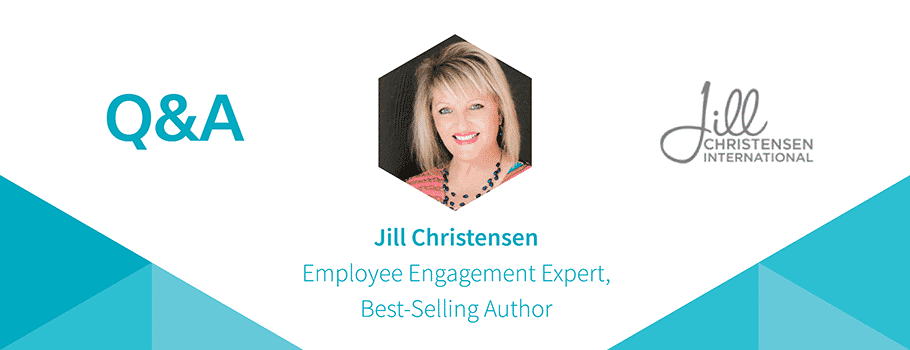The most successful companies in the world have the highest levels of employee engagement, yet engagement initiatives are frequently put on the back burner. Or, they’re put solely in the hands of HR when senior leaders from every department should be involved.
What are the most effective ways to engage employees? How are operations and employee engagement related? What’s the cost of a disengaged workforce? We have a special guest here to tell you. Since employee engagement is such a hot topic, we’re honored to share insider knowledge from expert, Jill Christensen, who sat down with us to answer some questions.
With three decades of consulting, speaking, and global Fortune 500 executive-level experience under her belt, Jill has dedicated her career to engaging employees to improve productivity, retention, customer satisfaction, and revenue growth with clients like AT&T, Nokia, Crocs, and Novartis. She is Founder/President of Jill Christensen International, a best-selling author and international keynote speaker, and was recently named a Top 100 Global Employee Engagement Influencer for 2017. She also led Global Internal Communications at Avaya and Western Union.
Needless to say, she has some great insights about challenges and solutions in the employee engagement department. Now let’s hear from Jill herself!
1. Why did you decide to dedicate your career to employee engagement?
As a consultant, I got the opportunity to work in many different industries. In virtually every company where I worked, employees were unhappy and the company operated in a dysfunctional manner. I thought to myself that someone needs to fix this, so I dedicated my career to teaching leaders how to change their cultures and re-engage employees.
2. Tell us about your book and what inspired you to write it.
I want to fix every broken business culture in the world, so I thought the best way to reach everyone is to write a book about how to re-engage employees and make it available on Amazon! My book, “If Not You, Who? How to Crack the Code of Employee Disengagement,” focuses on a proven four-step process to re-engage employees, which people can execute on immediately.
3. You were a judge and keynote speaker at the Employee Engagement Awards. What criteria do you look for in the winner?
The most important criteria is innovation. As a judge, I look for companies that have developed creative solutions to re-engage employees. In addition, I’m looking for sustainability. Employee engagement is not a program or an initiative. It’s a journey that lasts for decades, so I’m looking for companies that create and execute on a long-term strategic plan.
4. How are employee engagement and customer engagement related?
There is a direct correlation between employee engagement/satisfaction and customer engagement/satisfaction. When your employees are engaged, they go above and beyond the call of duty and give you a lot of digressionary effort, which flows through to the customer experience.
5. How are employee engagement and operations related?
Operations management involves ensuring that business operations are efficient in terms of using as few resources as needed and effective in terms of meeting customer requirements. When employees are engaging, they are more productive, efficient, and aware of customer needs. They are on the ball, on top of things, and make fewer mistakes, so clearly, a business will operate more effectively when your employees are running on all cylinders and giving it their all.
6. What are the biggest consequences of a disengaged workforce?
Decreased productivity, creativity, customer satisfaction, and retention; increased absenteeism, theft, mistakes, safety, and quality issues. And the granddaddy of them all? Stagnant or decreased revenue growth, because we know there is a direct correlation between engagement and bottom line results. The most profitable companies in the world, and the companies that are growing the fastest, have the highest levels of engagement.
7. What extra challenges do companies face when trying to engage their non-desk workforce?
When you have a large non-desk workforce, you must ensure that your communications are mobile optimized. I don’t believe companies face additional challenges in this space. Why? Because desk or non-desk, all employees are people and all people are human beings. And at their core, human beings are wired the same way. For the most part, what motivates and inspires you, motivates and inspires me. What deflates and discourages you, deflates and discourages me. Very few people are motivated by money. In order to engage employees, you need to fulfill their basic human needs.
8. What are three tips for companies looking to drive engagement?
I have four, as presented in the strategy in my book. 1. Hire people whose individual values align with the company’s values. 2. Ensure that every employee has individual goals that align with the CEO’s goals. 3. Create a two-way communication culture. 4. Recognize people. When you do these things, it drives trust in senior leaders and causes employees to feel an emotional connection to the company, which is the definition of engagement.
9. What is the best employee engagement initiative you’ve seen a company roll out?
The best initiative is one that is strategic and long-term and championed by senior leaders vs. tactical and short-term and championed by HR. As I’ve said, employee engagement is not a program or an initiative. It’s a strategic journey that lasts for decades.
10. What do you think sets Beekeeper apart from other employee engagement tools?
Beekeeper’s differentiator is that it is geared toward geographically distanced employees. The tool enables field and remote employees to seamlessly connect and communicate with the entire organization in a simple, intuitive, and unified manner. It allows peer-to-peer messaging for team collaboration, as well as top-down communication for organizational alignment.







